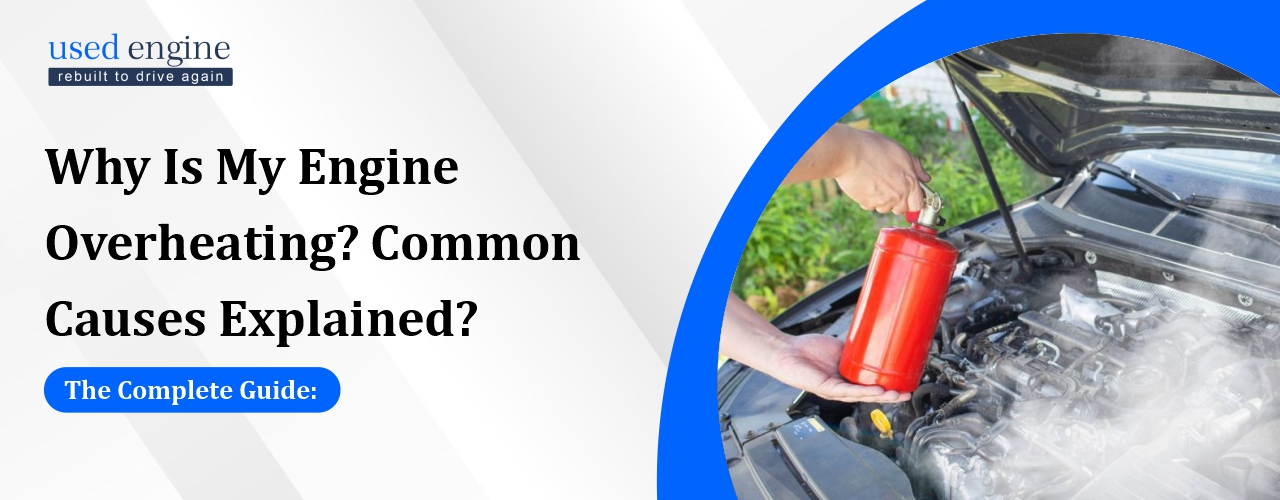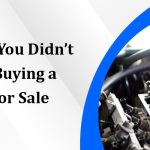
One of the signs that you should change your engine part is overheating again and again. But you can also prevent the Engine overheat by applying the some of the tips. Here you will get to know why your car Engine overheats and how you can cool it up with the help of some tips.
Reasons: Why Engine Overheats
- Low coolant: It sounds stupidly simple, but check the coolant first. People top off oil religiously but forget the other fluid that actually keeps the engine alive. If the level’s low, there’s either a leak or it just hasn’t been checked in months.
- Bad thermostat: This little part gets ignored until it sticks shut and suddenly, you’re watching the temp needle climb like a rocket. The used engine can’t circulate coolant if the thermostat won’t open, so it just cooks itself.
- Radiator issues: Clogged fins, leaking hoses, busted radiator cap—take your pick. If the radiator can’t move heat away fast enough, you’re in trouble. I once had a cap that lost pressure, and the coolant boiled at a way lower temp. Instant headache.
- Water pump failure: If the pump’s impeller is worn out or the belt slips, the coolant isn’t moving. You’ll see overheating at idle or under load because the circulation just isn’t happening.
- Cooling fan not kicking in: Modern cars rely on electric fans a lot more than you’d think. If the fan relay, sensor, or motor goes bad, the fan won’t spin, and you’ll overheat sitting in traffic but be fine cruising on the highway.
- Air pockets: This one’s sneaky. You flush the system or top it off wrong, and now there’s an air bubble stuck somewhere. That bubble keeps coolant from reaching hot spots, and overheating problem starts.
- Head gasket: If you’ve ruled out everything else and it’s still running hot, blowing white smoke, or losing coolant with no leaks, it’s probably a head gasket.
How to Resolve the Engine Overheat Problem?
Don’t keep driving
Pull over. Disable the AC if you had it on, crank the heater instead. Shut the car off once you’re safely stopped. Let it sit. Do not, rip the radiator cap off while it’s hot unless you enjoy boiling coolant all over your arms.
Check obvious stuff
Pop the hood once the steam dies down. Coolant level is the number one suspect. If it’s low, that’s usually the whole story, leak somewhere or just long-term neglect. Top it off with coolant or even plain water in an emergency. Don’t overthink it if you’re stranded; get liquid in there so the engine can actually cool.
If the coolant looks fine, next is the fan
Electric cooling fans should kick on when the car gets hot. If you don’t hear them spinning, you’ve got a dead fan motor, blown fuse, or a bad relay. Easy to miss because the car will sit there quietly cooking itself.
Hoses are another weak point
Look for splits, bulges, or just old crusty rubber. A busted upper radiator hose will empty your coolant in seconds. I once had one blow out on the highway—looked like someone dumped a bucket under the car.
Thermostat can stick closed too
That one’s annoying because it’s inside the system. If your top radiator hose stays cool while the engine is roasting, that thermostat probably isn’t opening. Cheap part, but a pain if you’re stuck without tools.
water pump or a blown head gasket
Pump failures usually mean coolant is just not circulating at all, and you’ll see leaks around it. Head gasket is ugly-white smoke out the exhaust, oil looking like chocolate milk, coolant vanishing for no reason. If you’re here, it’s not a quick roadside fix.
So, immediate action plan if your engine overheats:
- Pull over, shut it down, let it cool.
- Check coolant and top it off if it’s low.
- Check fans and fuses if coolant looks fine.
- Scan for obvious hose leaks or drips.
- If none of that fixes it, get it to a shop before you cook the motor.
How to Purchase Auto Parts from Usedengine.forsale?
- Go to the site: Type in usedengine.forsale. The homepage is kind of barebones — feels like those old-school classified style parts sites.
- Use the search bar: You’ll see a big search box asking for “Year / Make / Model.” Punch in what you’re looking for. Example: 2012 Honda Accord engine. Hit search.
- Browse results: It’ll pull up a list of engines or parts available. Some come from their own stock, others from partner yards. The listings usually include mileage, condition, warranty info, and price. Read carefully, not all quality used engines are the same. Some are low mileage; some are basically beat.
- Pick your part: Once you see one that makes sense (price + mileage + warranty all check out), click it. You’ll get a detail page with more info.
- Call or request a quote: This site isn’t always a straight “add to cart, pay, done” type of setup. For a lot of listings, you either fill out a contact form or call the number they give. It connects you with a rep who checks availability and confirms shipping costs. It feels a little old-school and simple, but that’s how these salvage/used part networks work.
- Confirm and pay: They’ll usually email you an invoice. Most accept credit card, PayPal, sometimes even bank transfer if you’re dealing with a bigger item like a full engine. Pay it, and keep that invoice in your inbox – that’s your proof if anything goes wrong.
- Shipping / delivery: Engines and transmissions ship via freight, not UPS. So, expect a truck delivery, sometimes curbside. Smaller parts may come through FedEx/UPS. Make sure you’ve got someone around to help unload heavy stuff, because drivers don’t always help.


 Top 5 Things You Didn’t Know About Buying a Used Engine for Sale
Top 5 Things You Didn’t Know About Buying a Used Engine for Sale How to Find a Used Engine and Transmission Store with Warranty Parts
How to Find a Used Engine and Transmission Store with Warranty Parts How a Quality Used Engine Can Save Your Classic Car from Being Scrapped
How a Quality Used Engine Can Save Your Classic Car from Being Scrapped Why Used Engines Are the Ultimate Game Changer?
Why Used Engines Are the Ultimate Game Changer? Why Is My Engine Overheating? Common Causes Explained?
Why Is My Engine Overheating? Common Causes Explained?